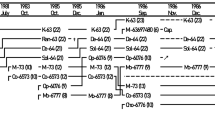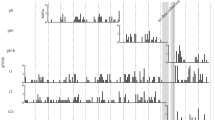Abstract
Data on the social behaviour of a free-ranging troop of Stumptail macaques are reported for a period starting of August 15th to November 7th of 1974.
Positive interactions take a greater part in the daily life of the troop than negative interactions. Individuals order themselves in an essentially linear dominance hierarchy and offspring rank immediately below their mother. Agonism and displacement are good predictors of dominance rank. Dominant individuals are a strong source of attraction for subordinates and the alpha male is a powerful social magnet for immatures.
Grooming was found to be correlated with dominance rank and individuals holding adjacent ranks tend to interact positively with one another. To gain access to dominant females, subordinates direct a great deal of positive behaviour to the female’s youngest offspring.
As social distance decreases the selection of a social partner becomes more strict and tends toward adjacency. However, factors such as motherhood, genealogical ties, and special relationships with non adjacent individuals, can override the tendency.
The direction and quantity of male-care displayed by the adult male and by juvenile males toward younger individuals was found to be influenced by the troop’s dominance patterns. Sex differences were found to exist in male-care received and a negative association was found with the age of the receiver.
Adult females are the main regulators of social relations and their rank and friendships provide their offspring with the social format, before puberty, in which they develop socially. The alpha male is the group protector, the performer of policing, an important element in the immatures’ social development, and a powerful source of attraction for all troop members.
Similar content being viewed by others
References
Altmann, J., 1974. Observational study of behaviour: Sampling methods.Behaviour, 49: 227–263.
Bertrand, M., 1969.The Behavioral Repertoire of the Stumptail Macaque. Bibliotheca Primatologica, No. 11, S. Karger, Basel, Switzerland.
Estrada, A., 1977. A ten month field study on the ontogeny of social relations in a free-ranging troop of stumptail macaques (Macaca arctoides). Ph.D Thesis, Rutgers University.
————, &R. Estrada, 1976. Establishment of a free-ranging colony of stumptail macaques (Macaca arctoides): Relations to the ecology I.Primates, 17: 337–355.
———— & ————, 1977a. Patterns of predation in a free-ranging troop of stumptail macaques (Macaca arctoides): Relations to the ecology II.Primates, 18: 633–646.
---- & ----, 1977b. Changes in the social structure after the introduction of a second group in a free-ranging troop of stumptail macaques (Macaca arctoides): Social Relations II., in prep.
---- &J. Sandoval, in press. Social relations in a free-ranging troop of stumptail macaques (Macaca arctoides): Male-care behaviour I,Primates.
Gouzoules, H., 1973. Maternal rank influence on group member’s interactions with infants inMacaca arctoides. M. A. Thesis, University of Georgia.
Kawai, M., 1965. On the system of social ranks in a natural troop of Japanese monkeys: (I) Basic rank dependent rank. In:Japanese Monkeys: A Collection of Translations,K. Imanishi & S. A. Altmann (eds.), University of Alberta, pp. 66–87.
Kawamura, S., 1965. Matriarchal social ranks in the Minoo-B troop: A Study of the rank system of Japanese monkeys. In:Japanese Monkeys, A Collection of Translations,K. Imanishi & S. A. Altmann (eds.), University of Alberta, pp. 105–112.
Koford, C. B., 1963. Rank of mothers and sons in bands of rhesus monkeys.Science, 141: 356–357.
Loy, J. &K. Loy, 1972. Behaviour of an all-juvenile group of rhesus monkeys.Am. J. Phys. Anthrop., 40: 83–96.
MacDonald, G. J., 1971. Reproductive patterns of three species of macaques.Fertil. Steril., 22: 373–377.
Missakian, E., 1972. Genealogical and cross-genealogical dominance relationship in a group of free-ranging rhesus monkeys (Macaca mulatta) on Cayo Santiago.Primates, 13: 169–180.
Oakes, E. R., 1967. The determinants of social status in a colony of femaleMacaca speciosa. Ph.D Thesis, University of Oklahoma.
Ransom, T. W. &B. S. Ransom, 1971. Adult male-infant relations among baboons (Papio anubis).Folia primat., 16: 179–195.
———— &T. E. Rowell, 1972. Early social development of feral baboons. In:Primate Socialization,F. E. Poirier (ed.), Random House, N. Y., pp. 105–144.
Richards, S. M., 1974. The concept of dominance and methods of assessment.Anim. Behav., 22: 914–928.
Rhine, R. J. &C. Kronenwetter, 1972. Interaction patterns of two newly formed groups of stumptail macaques (Macaca arctoides).Primates, 13: 19–33.
Rhine, R. J., 1972. Changes in the social structure of two groups of stumptail macaques (Macaca arctoides).Primates, 13: 181–194.
————, 1973. Variation and consistency in the social behaviour of two groups of stumptail macaques (Macaca arctoides).Primates, 14: 21–35.
---- &H. H. Neely, 1974. Social development in stumptail macaques (Macaca arctoides): Interactions with adult males during the infants’ first 60 days of life. Unpublished report.
Rowell, T., 1972.Social Behaviour of Monkeys. Penguin Books, Baltimore, 203 pp.
Sade, D., 1967. Determinants of dominance in a group of free-ranging rhesus monkeys. In:Social Communication Among Primates,S. A. Altmann (ed.), University of Chicago, pp. 99–114.
Welkowitz, J. R., B. Ewen, &J. Cohen, 1971.Introductory Statistics for the Behavioral Sciences. Academic Press, New York.
Wilson, C, 1972. Spatial factors and the behavior of non human primates.Folia primat., 18: 256–275.
Author information
Authors and Affiliations
About this article
Cite this article
Estrada, A., Estrada, R. & Ervin, F. Establishment of a free-ranging colony of stumptail macaques (Macaca arctoides): Social relations I. Primates 18, 647–676 (1977). https://doi.org/10.1007/BF02383141
Received:
Accepted:
Issue Date:
DOI: https://doi.org/10.1007/BF02383141




